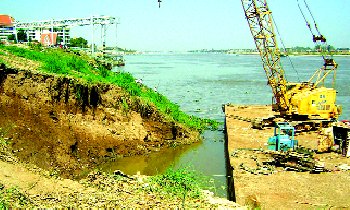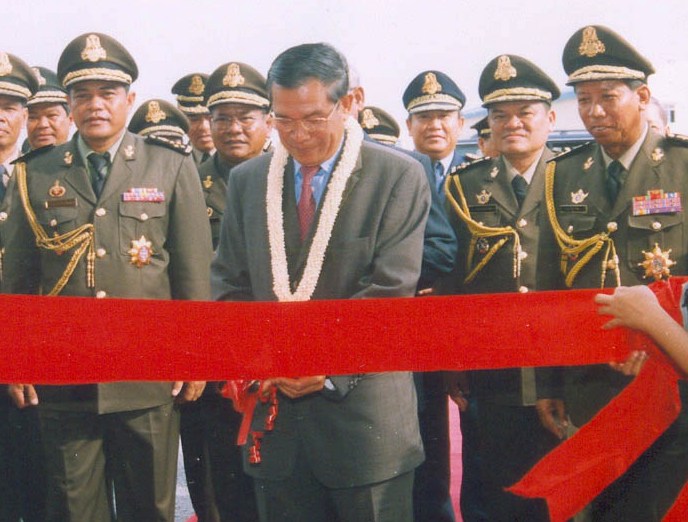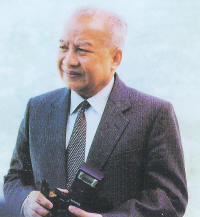MEET WITH
GOD |
PHN@M - P@NH - P@TINS
|
RENCONTRER
DIEU |
THE CAMBODIAN PEOPLE OWNS ITS PETROLEUM (2005-Jan-17)
THE RGC DOESN'T
Baphuon : ChevronTexaco announced on January 13, 2005 that its
affiliate has discovered oil in four exploration wells in offshore Cambodia
south of Sihanoukville. (...) A preliminary estimate for the area shows
about 106 trillion to 176 trillion cubic feet of gas, and 400 million barrels
of crude oil, according to the Cambodian National Petroleum Authority.
So, based on the current price of crude oil of $47 per barrel and the price
of Russian natural gas sold to European countries in 2003 ($87.11 per 1000
cubic meter), the above quoted quantities would generate a revenue of
$18.8
billion for the crude oil and $435 billion
for natural gas before the deduction of the cost of production and taxes.
Therefore the question is: Who Owns the Petroleum
Money? Who has the power to spend that Petrol Money? It is not
the government money. That Petrol Money belongs to the Cambodian People.
On Dec 21, Prince Norodom Ranariddh, president of Cambodia's National Assembly,
said one of the discoveries had substantial economic viability and the
extraction could begin by 2007.
There have also been disputes with neighbouring Thailand over sovereignty.
Cambodia lacks legislation covering natural resources extraction and Ranariddh
said the International Monetary Fund had suggested the country pass laws
before beginning to tap reserves. (...) Cambodian
Petroleum Money Should Assure the Social Justice and Freedom and Democracy
for the Khmer People. The Khmer People Owns all Natural Resources.
The Royal Government of Cambodia (RGC) has no right to spend Cambodian
Petrol Money. (...) The law on the extraction of Khmer Petroleum that the
Cambodian National Assembly would pass ought to assure the social justice
in order to help ordinary people. Because injustice and violation of human
rights would lead the interminable cycle of street demonstration/repression.
Then it ends up scaring investors. (...) Cambodia forest was already gone.
Our other national natural resources would be gone also if they were exploited.
(...) The Cambodia government did not own Cambodia Petroleum. The Cambodia
government had no right to use Cambodia Petroleum money to pay its administration,
to pay National education bill, to build schools, or to build infrastructure,
bridges, dams, freeways, etc. Cambodia Petroleum
Money belongs to the Cambodian People only.
The Cambodian People owns that money. (...) Cambodia should follow the
example of the Alaska Permanent Fund Dividend
Program. The Alaska Permanent Fund Dividend Program is governed
by a board of trustees appointed by the government approved by Alaska State
assembly for six years (the same way as the Supreme Court judges were appointed).
For example, assuming that for the end of fiscal year the Cambodia Petroleum
net income is 1.6 billion and Cambodia Trustees Board decided to distribute
one billion dollars of dividend to the Cambodia people, and invest $600
million in real estate ; and assuming that there are 10 million Cambodian
citizens living in Cambodia (all Cambodian citizen from one day old). Each
Cambodian citizen living in Cambodia will receive a check of one hundred
dollars (that is $1 billion divided by 10 million) for that fiscal year.
That is, in general, the way the Alaska Permanent Fund Dividend Program
operated in order to distribute the Alaska Petroleum money. Alaska Petroleum
did not belong to Alaska government, but to Alaska people only.
CONCLUSION: Cambodian Law on the extraction of Natural Resources should
be similar to the Alaska Permanent Fund Constitution (see http://www.apfc.org).
[in RepublicofCambodia]
AlexanderIII : Let me insert some of my understanding based on current
events and state of the State. I spent quite a bit of time managing the
digging for natural resources at Ecuador, Bolivia and Ukraine. It wasn't
the digging that gave me and others headaches, it was the red tapes. The
lesser the red tapes Cambodian Gov't has, the better distributed the country
economy will be. Unfortunately, there were no courses on how to deal with
red tape at University of Phoenix - Online for me. Someone asked couple
weeks back, how do we pay for national debt? Well, there is no such thing
as a free lunch from the World Bank or the UN. This oil money is one of
the ways Cambodia can refund the national debts. I am not saying that we
must, but we should. Maybe my assumption is incorrect but if I was to ask
to flip the switch, that is what I would do. (...) Gov't does not own natural
resources, but it shall protect the interest of the people and safeguard
the treasure (given that cleaning up corruption progresses). Gov't shall
have the power to distribute the wealth not in terms of $$$, but in terms
of national infrastructure, education and investment from the exporting
of oil and gas. [in Camdisc] |
ChimS1 : I believe that dispensation of cash is not advantageous
to the people of Cambodia. In spite of natural resource and cash allowance
for each of the citizens in the State of Alaska, this State still remains
one of the poorest in the US. The Middle East is another example of cash
distribution that goes to current spending rather than to the development
of human resources and human capital. Moreover, current cash distribution
tends to generate inequality and even distortion in terms of social justice
over the long run. The investment in human capital and national infrastructure
would seek a better long term growth that can be spreaded toward the whole
society in terms of motivation and human energies. The ethical and intellectual
development of the people is much more advantageous and substantial than
present consumption and relief of current hardship. We cannot eat inspiration.
However, it's the only thing that can lift up the spirit of the whole nation
to move mountains and undertake exciting enterprises for all the people
in Cambodia. [in Soc.Culture.Cambodia] |
N.P. : Since 1993, Cambodia old natural
resources like forests, fish and fertile lands have been dilapidated or
mismanaged by the accomplices Hun Sen-Ranariddh. The new natural resources
(oil and gas) have a good chance to enrich Cambodian officials rather than
the State of Cambodia et encore moins le peuple du Cambodge. In
a totalitarian regime the State coffer and the leaders' pockets are linked
by a unchecked pipeline. Right before the collapse of their reign, Saddam
Hussein and sons were seen at the Bank of Iraq taking 1 billion U.S.$
away.
Before exploiting its oil and gas Cambodia shall first change its governants.
Les berges tombantes du Mékong (2005-Jan-11)
Exemple du pont "français" de Kbal
Thnâl

|

|
N.P. : Peut-on empêcher des pans
de berge du Mékong de se détacher et tomber dans le fleuve
puis devenir à leur tour du limon alimentant la croissance d'autres
berges en aval ? Les lois empiriques de l'hydrologie et de la mécanique
des sols permettent de prévoir le tracé sans cesse changeant
d'un fleuve puissant (comme le Mékong) à travers un terrain
meuble (comme la plaine du Cambodge). Il y a des berges condamnées
à tomber et celles à s'accroître, dépendant
de leur concavité (ou convexité) par rapport au sens du courant
(cf. croquis d'en bas).
Selon le Koh Santepheap Daily, un autre pan de berge du Bassac s'est détaché
du jardin "Samdech Hun Sèn" dans la nuit du 28 au 29 décembre
2004. Kèp Chuktéma et sa municipalité devraient penser
à l'astuce de la compagnie française qui a construit le nouveau
pont reliant Phnom Penh et Chbar Ampeou. Ce pont, à caissons en
béton précontraint construit en encorbellement au milieu
des années 60, a de quoi étonner les maniaques des travées
continues.

|

|
En effet, la travée AB est indépendante du tablier continu
BCDE (cf. croquis d'en haut). On était sûr que la berge en
A aura un jour des problèmes, alors il valait mieux laisser partir,
le cas échéant, la culée et la travée sans
qu'elles entraînent tout le pont ... puis reconstruire après
la partie AB. Les ingénieurs de la ville devraient savoir que leurs
réparations de la berge ne sont que temporaires. Ça recommencera.
[Nouvelle et photo de Koh Santepheap]
Les 7 Janvier-Cavaliers de l'Apocalypse (2005-Jan-07)

L'inauguration d'une nouvelle ère de calamités
au Cambodge
2005 looks grim for Cambodia (2005-Jan-02)
Unemployment is a time-bomb for Cambodia
There are no credible statistics to measure unemployment in this country.
If some peaks in agricultural employment – totally a few months a year
– are put aside, joblessness probably exceeds
50% most of the time throughout the year, taking into account
landless farmers, beggars, prostitutes, scavengers, unpaid family workers,
and destitute people doing petty and occasional jobs because they have
no alternative livelihoods for survival (disguised unemployment).
Cambodia currently has a population of over 13 million inhabitants, of
which more than 50 percent are less than 20-year old.
Each year, approximately 300,000 people leave school or reach the age to
look for a job. Only 30,000 to 40,000 jobs
have been annually created over the last ten years, of which 25,000
in the garment industry (which now employs about 250,000 workers).
Starting from 2005, with the end of the quota system in the garment industry,
prospects for job creations look rather dim. Even though, from an optimistic
point of view, up to 30,000 jobs could still be created every year
thanks to the anticipated growth of tourism and some other industries such
as trade and construction, this would represent at best only 10 percent
of the annual additional workforce. Therefore, joblessness will dramatically
increase in the years to come. On the basis of the above figures, unemployment
can be seen as a time-bomb for Cambodia. Consequences will be reflected
in an increase in poverty, prostitution, human trafficking, illegal emigration,
criminality, drug consumption, and all forms of violence
(robberies, murders, acts of banditry, proliferation of gangs, domestic
violence, and suicides). That type of situation will likely lead
to social and political unrest. [K.I.] |
Government faces worsening food
crisis
With
the worsening poverty which has been recently compounded by a nationwide
drought, the government is facing an increasing number of hungry
farmers begging for food. Everyday, thousands of destitute people come
or write to Prime Minister Hun Sen asking for aid to avoid starvation.
Because he cannot cope with the surging needs of the people, Hun Sen has
started to re-direct the incoming popular requests to King Norodom Sihamoni
and King-Father Norodom Sihanouk. The government
has an annual budget of approximately $800 million compared to $5 million
for the Royal Palace.
Many
observers think Cambodia's current food crisis has structural causes
and cannot be addressed through the distribution of alms in a paternalistic
style. Fundamental reforms regarding the management of land, forest and
fisheries, and a policy change regarding the fight against corruption
and the setting of different priorities (agriculture, irrigation) are needed
to prevent chronic food shortages. In the 1960's Cambodia – a country blessed
by Mother Nature – could abundantly feed herself and was the world's third
largest exporter of rice. [K.I.]
|
La statue de Samdech Preah Dhammalikhit Louis
Èm (2004-Déc-28)
N.P. : Avez-vous vu au Cambodge, à
part le Bouddha, Jaya VII et Surya II, des statues de Cambodgiens célèbres
autres que Ang Duong, Norodom, Sisowath, Monivong et Sihanouk ? Eh bien,
j'ai vu une statue du Très Vénérable Louis
Èm que j'ai connu dans mon adolescence
à la pagode Vatt Lanka. Rappelons que, avant le décès
de l'érudit Samdech Souk, chef de l'Ordre Mohanikay, le numéro
deux du clergé était le Preah Bodhivangsa Louis Èm
alors que le Preah Buddhaghoçachar Chuon
Nat n'était que le numéro
trois. Ce dernier fut nommé chef de clergé parce qu'il était
le guru du roi Sihanouk.
La pagode Lanka apparut ainsi comme la concurrente de Vatt Unnalom, fief
de Samdech Chuon Nat, tant sur le plan de la qualité et du nombre
des "docteurs en pali-sanskrit" que sur celui des installations architecturales.
Vatt Lanka fut le premier, sous l'impulsion de l'énergique Lok Achar
Srey Thinn, à reconstruire son Vihear (chapelle) en édifice
à deux étages alors que le Vihear de Vatt Unnalom aura son
deuxième (et même troisième) étage plusieurs
mois après.
Samdech Èm, modeste et effacé de nature, ne voulait pas de
statue (d'ailleurs aucun bonze supérieur n'en avait dans l'histoire
du Cambodge) mais ses paroissiens tenaient à lui en faire construire
une par amour et par vénération. Quand la statue (en bronze
moulé, grandeur nature) est achevée, il se passa quelque
chose de curieux : on n'osa pas l'exposer
à l'extérieur sur une place d'honneur
dans la pagode, pour ne pas déplaire à la fois au chef de
l'Ordre, Samdech Chuon Nat (qui n'avait pas encore de statue) et au prince
Sihanouk,
ex-roi-dieu tout puissant qui nommait par décret tous les hauts
dignitaires du clergé bouddhiste [alors que évêques
et cardinaux catholiques sont nommés par le pape, lui-même
élu par le sacré-collège].
La statue finissait donc par être abandonnée au nouveau deuxième
étage de la chapelle, moins fréquenté que le premier
étage. J'ai dit "abandonnée" car personne n'en prenait soin.
J'ai vu une fois ou deux, quand je "me promenais" dans la pagode, Samdech
Louis Èm (la statue) couvert de poussière et de toiles d'araignée,
assis à même le plancher en position du Bouddha en Dukkha
Kiriya (pénitence), derrière l'autel réservé
aux grandes et petites statues du Çakya Muni, sans fleurs ni encens
ni bougies et, dernière humiliation, invisible à la fois
des fidèles qui venaient prier et des bonzes qui récitaient
des mantra.
Si d'aventure cette statue est encore là, à la pagode Vatt
Lanka, les Phnompenhois actuels devraient
lui faire honneur en l'exposant sur un piédestal à l'extérieur,
montrant ainsi à l'Histoire qu'il y a des Cambodgiens célèbres
autres que les rois pécheurs
(pour ne pas dire rois maudits)
khmers, descendants de Sdech Kân ou de Chey Chetha II.
Ranariddh wants to sell Funcinpec headquarters
Samngatki : Prince Norodom Ranariddh has officially confirmed his
intention to sell the present Funcinpec headquarters located next to the
French embassy for approximately U.S. $3 million. The official reason for
his decision is related to feng shui
(in Khmer Heng Soy) considerations (the present location has allegedly
brought bad luck to the royalist party as evidenced by its successive electoral
defeats since 1998). But the real reason for the projected sale seems to
have more to do with financial considerations since a huge profit will
be made – a portion of which under the table – following the transfer of
the headquarters to a remote and much cheaper location. In the eyes of
many Funcinpec supporters, Ranariddh's decision raises a number of sensitive
questions related to: 1) The impressive North Korean-given bronze
statue of retired King Norodom Sihanouk – Funcinpec's revered
Founding-Father – that dominates the present party's headquarters. |
|
The
quasi-religious statue will have to be unceremoniously deposed, truck-carried
and re-installed in a new place some people fear will be in the middle
of paddy-fields. 2) The symbolism of a vanishing political
party that is selling off, or ready to sell off, everything from its name
and its identity (as evidenced by Ranariddh's recent offer to merge his
party with the CPP) to its historic headquarters. To many Funcinpec members
Ranariddh just gives the impression that he doesn't care any longer about
the future of his party.
GOD
vs BUDDHA
|
camboDIATRIBE
|
COURRI@L
2005
|
AUTRES
SITES KHMERS
|
KUN
PIMOJ 's HOMEPAGE
|
PHN@M-P@NH-P@TINS
(
PREVIOUS )
|
FRAN-GLO-GIBWÉ
|
CANADA
3 FOUNDERS
|
MES
EMAILS 2003
|
THE
6 COMMANDMENTS
|
MEET
WITH GOD
|
PEN Nearovi, Montréal, Québec, Canada
(nearovi@sympatico.ca)






